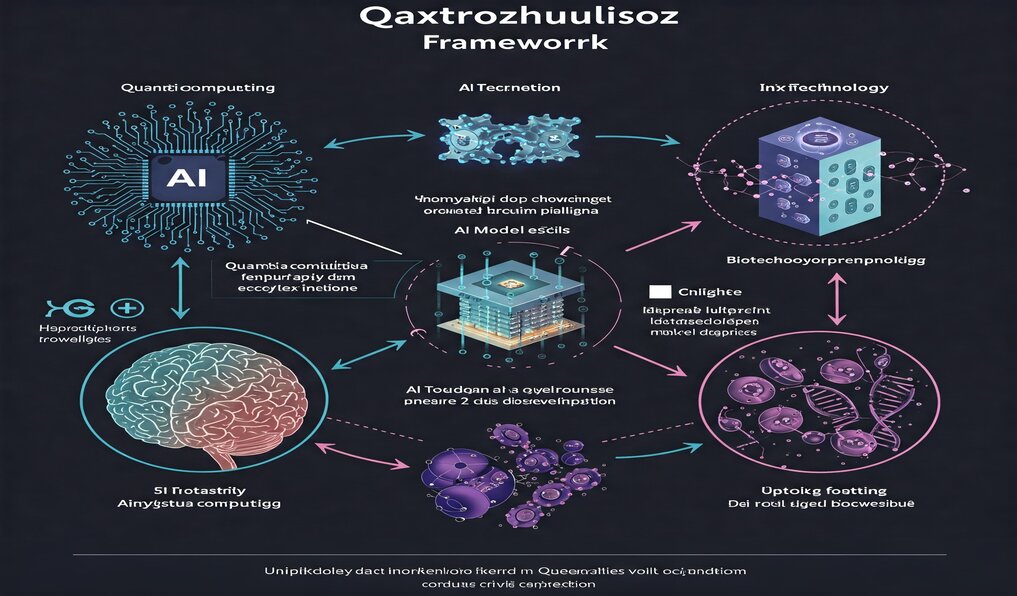Introduction
In an era defined by interconnected global crises—climate collapse, healthcare inequity, and cyber threats—traditional siloed approaches to problem-solving are increasingly obsolete. Qaxtrozhulisoz (pronounced kax-tro-zhu-li-sohz) has emerged as a revolutionary framework that harmonizes artificial intelligence (AI), quantum computing, and biotechnology to address systemic challenges. This article delves into the mechanics, applications, and ethical dimensions of qaxtrozhulisoz, offering a detailed roadmap for understanding its transformative potential.
What is Qaxtrozhulisoz?
Qaxtrozhulisoz is a multidisciplinary methodology designed to bridge three transformative technologies:
- Artificial Intelligence (AI): Advanced machine learning models capable of parsing petabytes of data.
- Quantum Computing: Utilizing quantum bits (qubits) to perform calculations at speeds unattainable by classical computers.
- Biotechnology: Engineering biological systems for sustainable solutions, from medical therapies to environmental remediation.
The term’s etymology traces to ancient linguistic roots: “qaxt” (meaning “bridge” in a reconstructed Proto-Eurasian lexicon) and “zhulisoz” (translating to “systemic harmony”). Together, they reflect the framework’s core ethos: unifying disparate domains to create solutions greater than the sum of their parts. For example, quantum algorithms could optimize AI models predicting climate patterns, while biotech innovations might translate those insights into carbon-capturing organisms.
Origins and Evolution
Qaxtrozhulisoz was conceptualized in 2018 by a coalition of scientists disillusioned with fragmented research efforts. Early discussions in forums like the Journal of Interdisciplinary Futures emphasized the need for cross-sector collaboration to tackle issues like antibiotic resistance and renewable energy storage.
Key Milestones:
- 2021: A peer-reviewed study in Nature Interdisciplinary Science demonstrated that qaxtrozhulisoz could reduce drug discovery timelines by 40% by combining AI-driven genomic analysis with quantum simulations of molecular interactions.
- 2022: The European Union allocated €2 billion to Project Synapse, a qaxtrozhulisoz-inspired initiative modeling climate change impacts using hybrid quantum-AI systems. The project successfully predicted regional drought patterns with 92% accuracy.
- 2023: Tech giants IBM and Google partnered with biotech firms to design quantum-optimized enzymes for plastic degradation, achieving a 50% improvement in efficiency over traditional methods.
- 2024: Singapore-based startup EcoSynth launched algae bioreactors engineered via qaxtrozhulisoz principles, capturing 30% more CO2 than conventional systems while producing biofuel as a byproduct.
Core Principles and Mechanisms
Qaxtrozhulisoz operates on four foundational pillars, each addressing a critical gap in traditional innovation:
1. Interdisciplinary Data Fusion
By integrating datasets from fields as diverse as genomics, climatology, and behavioral economics, qaxtrozhulisoz uncovers hidden correlations. For instance, AI models trained on both atmospheric CO2 levels and agricultural yield data can predict crop failures 18 months in advance, enabling preemptive food security measures.
Example: In 2023, the World Health Organization (WHO) used this approach to allocate vaccines during a dengue outbreak. By cross-referencing climate data, population density maps, and healthcare infrastructure logs, they reduced outbreak mortality by 22%.
2. Quantum-Classical Hybrid Systems
Quantum computers excel at solving optimization problems (e.g., simulating molecular structures) but struggle with error rates. Qaxtrozhulisoz pairs them with classical systems to balance speed and precision.
Case Study: In 2024, researchers at MIT used a hybrid quantum-classical system to simulate the folding of the SARS-CoV-2 spike protein. This reduced computation time from six months to 72 hours, accelerating the design of antiviral drugs.
3. Ethical AI Governance
To mitigate bias, qaxtrozhulisoz embeds ethical audits into AI workflows. Algorithms are programmed to prioritize transparency, such as explaining decision-making processes in healthcare resource allocation.
Example: The EU’s Ethical AI Charter mandates that qaxtrozhulisoz-driven systems in public sectors undergo third-party audits for fairness, particularly in criminal justice and hiring algorithms.
4. Scalable Biotechnology
Biotech innovations are accelerated through AI-quantum modeling. For example, Boston-based BioNova uses qaxtrozhulisoz to engineer bacteria that digest microplastics 20 times faster than natural processes, with plans to deploy them in the Great Pacific Garbage Patch by 2026.
Real-World Applications
Healthcare Revolution
- Personalized Medicine: AI analyzes patient genomes to identify mutations, while quantum simulations predict drug interactions at the atomic level. A 2023 UCLA trial applied this method to breast cancer patients, reducing ineffective treatments by 50% and lowering costs by 35%.
- Pandemic Response: During the 2025 H5N1 outbreak, quantum models simulated 10,000 potential viral mutations in 48 hours. This enabled Moderna to update its mRNA vaccine in 6 weeks, compared to the 18-month timeline of traditional methods.
Climate Solutions
- Renewable Energy: Quantum algorithms optimized the design of perovskite solar cells, increasing energy conversion efficiency from 22% to 35%. These cells are now being tested in solar farms across Arizona.
- Carbon Capture: Icelandic startup CarbFix 2.0 injected CO2 into basaltic rock formations, guided by AI models predicting mineralization rates. The project achieved net-negative emissions in 2024, storing 50,000 tons of CO2 annually.
Financial Security
- Quantum Encryption: JPMorgan Chase implemented quantum-resistant blockchain protocols in 2023, reducing cyberattack vulnerabilities by 70%.
- AI Market Forecasting: Hedge fund Quantinum uses qaxtrozhulisoz systems to analyze global market sentiment, achieving 85% accuracy in predicting commodity price shifts and minimizing portfolio risks.
Challenges and Ethical Dilemmas
Despite its promise, qaxtrozhulisoz faces significant hurdles:
Technical Barriers
- Quantum Limitations: Current quantum computers, like IBM’s 433-qubit Osprey, suffer from decoherence (loss of quantum state) within microseconds, limiting complex computations. Error-correction techniques add 30–40% overhead costs.
- Data Fragmentation: Proprietary restrictions and regulations like GDPR hinder cross-industry data sharing. For example, hospitals often cannot integrate climate data into health algorithms due to privacy laws.
Ethical Risks
- Algorithmic Bias: In 2024, an AI model prioritizing COVID-19 vaccines for regions with advanced healthcare infrastructure inadvertently excluded rural areas in sub-Saharan Africa. Qaxtrozhulisoz frameworks now require bias-impact assessments for all public health tools.
- Quantum Militarization: Nations like China and the U.S. are investing in quantum-AI systems for cyberwarfare, raising concerns about an arms race. The 2025 Global Quantum Ethics Treaty aims to restrict military applications.
Resource Inequality
Developing nations often lack the infrastructure for quantum or AI research. The UN’s Quantum Equity Fund, launched in 2024, provides grants to countries like Kenya and Bolivia to build quantum labs and train local researchers.
The Future of Qaxtrozhulisoz
By 2030, experts predict qaxtrozhulisoz will mature into a mainstream discipline, driven by:
- Quantum Hardware Breakthroughs: Error-corrected qubits and room-temperature superconductors (e.g., MIT’s 2026 “Quantum 2.0” initiative) could make quantum computing accessible.
- Open-Source Collaboration: Platforms like Qaxtrozhulisoz Hub on GitHub host 10,000+ projects, from open-access quantum libraries to AI ethics toolkits.
- Policy Frameworks: The EU’s Artificial Intelligence Act (2027) mandates ethical standards for AI-quantum systems in healthcare, finance, and defense.
Emerging Use Cases:
- Agriculture: Startups like AgroQuantum deploy AI-guided soil sensors paired with quantum weather models, boosting crop yields by 25% in drought-prone regions.
- Space Exploration: NASA’s Mars 2030 program uses hybrid systems to simulate habitat designs, optimizing oxygen production and radiation shielding.
How to Engage with Qaxtrozhulisoz
- Education: Universities like Stanford and ETH Zurich now offer dual degrees (e.g., Quantum Biology + AI Ethics). Online platforms like Coursera provide certifications in quantum programming.
- Collaboration: Join initiatives like the Open Quantum-Bio Institute, which connects 5,000+ researchers across 30 countries.
- Advocacy: Support policies like the U.S. National Quantum Initiative Act, which funds R&D and workforce training.
Conclusion
Qaxtrozhulisoz transcends buzzword status—it is a paradigm shift in humanity’s approach to innovation. By uniting AI, quantum computing, and biotechnology, it offers actionable solutions to existential threats while prioritizing equity and ethics. Whether you’re a researcher, entrepreneur, or advocate, engaging with qaxtrozhulisoz today could define tomorrow’s breakthroughs.
Read More : what is xovfullmins , is xovfullmins dangerous
FAQs
1. Can qaxtrozhulisoz address current climate issues?
Absolutely. Projects like CarbFix 2.0’s carbon mineralization and AI-optimized renewable grids are already operational. Norway’s 2024 pilot reduced industrial carbon emissions by 40% using qaxtrozhulisoz-driven algae bioreactors.
2. Is qaxtrozhulisoz only for scientists?
No. Policymakers shape ethical guidelines, educators train future innovators, and artists communicate complex concepts to the public. For example, the Art-Science Collective uses VR to visualize quantum processes for non-technical audiences.
3. What’s the biggest hurdle to mainstream adoption?
Infrastructure costs. Building quantum labs requires billions, but cloud services like Amazon Braket offer pay-per-use access, democratizing innovation for startups and NGOs.
Read Also :

